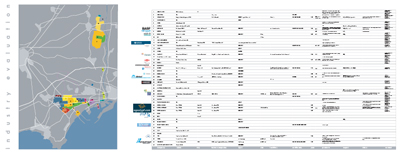Warning: this is going to be a long post divided in 2 parts...(continue)
1/2
So, yes, i know i've been terrible BLOGGER lately...sorry guys, i've been finding hard to adapt my timetables of life, student, and blogger here in Barcelona, anyways, here's a small scope of what was our first crit of the urban project we are doing in tarragona (catalunya), its just a small bit of all the investigation we had done for getting the essence on how to configure cities and what elements for them and how this really interact between them...a lot of material would be not posted here, and also lot of numbers, stadistics and such....i felt free on adding some text at the beggining of the whole show, its just some ideas i've been having and thinking after all the reading i did this first term...
First days of January we have the first crit of the year and we also need to have more or less a proposal for the urban planning we should develop...in order to choose 2 or 3 which would be the more interesting and develop them bewteen we all...
ok...the work:
“Everything should be made as simple as possible, but no simpler”.
- Albert Einstein.How to generate city?
A rough series of ideas
mariano
ariasdiez*
iaac2004
“the new city should generate situations rather than things.”
// FUNCTIONAL AUTONOMY:
In the course of pursuing any sufficiently ‘complicated problem' (the city), the subgoals that engage our attentions (the topics of study) can become increasingly detached from the original problem (the city).
Virtually any problem (city) will be easier to solve the more one learns about the context world in which that problem (city) occurs. No matter what one's problem is, provided that it's hard enough, one always gains from learning better ways to learn.
Our minds contain processes that enable us to solve problems we consider difficult. Intelligence is our name for whichever of those processes we don't yet understand.
// INTELIGENCI.TY
Intelligence emphasizes swiftness and efficiency. Taking as accounted, that a city should work as a brain, which means that it can learn and solve problems by itself and be functionally autonomous we can deduce this:
A brain (city) has no single common memory system. Instead each part of the brain (city) has several parts, types of memory-agencies that work in somewhat different ways, to suit particular purposes.
- Duplication:
Is it possible to design a city so that every one of its functions is embodied in several duplicated agents, in different places? Then, if any agent is disabled, one of its duplicates can be made to “take over”. A city based on this duplication scheme could be surprisingly robust.
- Distibuted processes:
Is it possible to design cities in which no function is located in any one specific place? Instead, each function is “spread out” over a range of locations, so that each part's activity contributes a little to each of several different functions. Then the destruction of any small portion will not destroy any function entirely but will only cause small impairments to many different functions.
- Simultaneity:
A new appreciation of “place” as a multiple and multiscalar “setting” or “field” of forces, not as merely physical or figurative context, and thus to a new definition of the project as a “reactive” mechanism: a relational and activating operation, at once strategic and tactical, capable of “reacting” to the place and at the same time “making it react”.
- GAUSA, Manuel. geoCat, IAAC 2004
- Micronemes:
That old idea of classifying things by properties is not entirely satisfactory, because so many kinds of qualities interact in complicated ways. Every situation or condition we experience is influenced or, so to speak, colored, by thousands of contextual shades and hues, just as looking through a tinted glass has faint effects on everything we see.
Those inner context hues that shade our minds activities in ways we can rarely express are what Minsky calls ‘micronemes'. Their inexpressibility reflects our and cities individuality.
// ACCUMULATION:
Consider that any city-generating scheme that begins by using the method of accumulation in which each agent tends to accumulate a family of subagents that can accomplish that agent's goals in several ways. Later, if any of those subagents become impaired, their supervisor will still be able to accomplish its job, because other of its subagents will remain to do that job, albeit in different ways. So accumulation provides both robustness and versatility.
“Never speak more clearly than you think”.
-Jeremy Bernstein the location, the site, the territory... [by peter jenni + nektarios kefalogiannis]
the location, the site, the territory... [by peter jenni + nektarios kefalogiannis] industry analysis of the site, with numbers of the year when the companies got stablished in Tarragona, the country of origin and also its headquarters location between other data... [by spela stern + ana garza]
industry analysis of the site, with numbers of the year when the companies got stablished in Tarragona, the country of origin and also its headquarters location between other data... [by spela stern + ana garza] migrations analysis in the site... [by roman silje]
migrations analysis in the site... [by roman silje] mobility and transportation mapping... [by roman cordero + alejandra rodriguez]
mobility and transportation mapping... [by roman cordero + alejandra rodriguez] tourism and public reference mapping [by wilm schwarzpaul + claudia dressler]*continues on next post...
tourism and public reference mapping [by wilm schwarzpaul + claudia dressler]*continues on next post...






No Comments
Block this user
Are you sure you want to block this user and hide all related comments throughout the site?
Archinect
This is your first comment on Archinect. Your comment will be visible once approved.